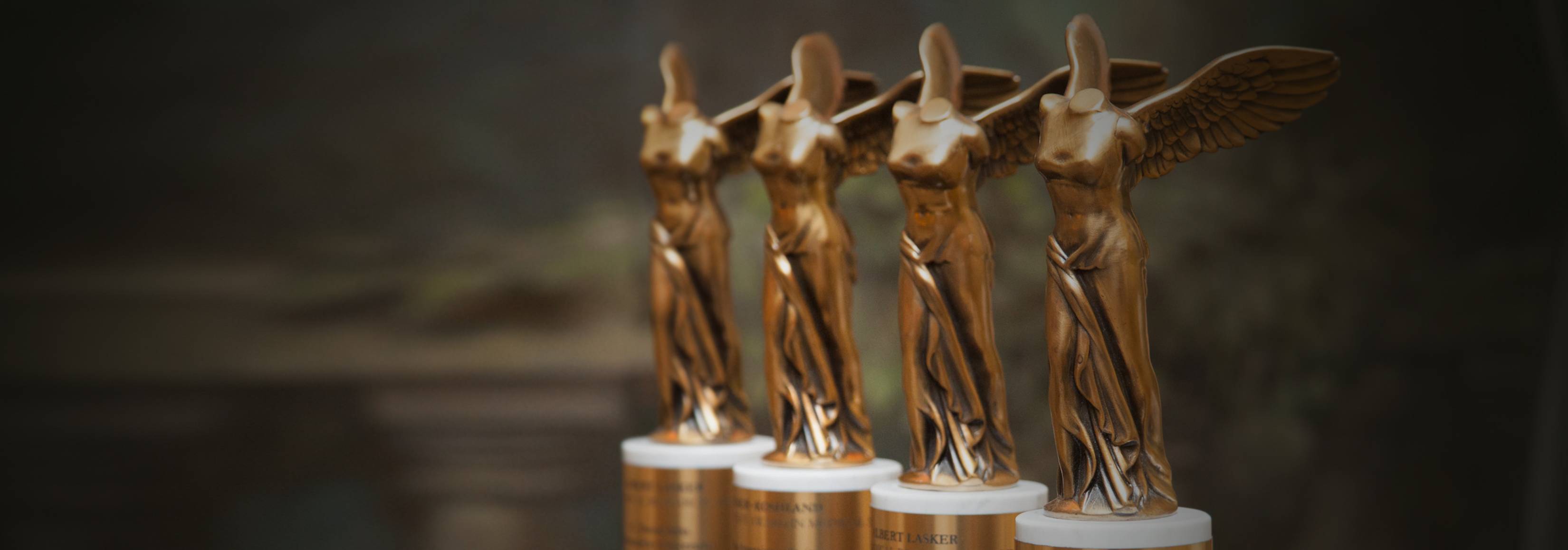The Rockefeller Institute for Medical Research was founded in 1901 with the primary aim of curing infectious diseases. Indeed, in laboratories the world over, intensive research efforts were being devoted to addressing the public health scourge created by bacterial infections like pneumonia, diphtheria, scarlet fever, anthrax and tuberculosis. Though most of the cures then available were highly toxic — arsenic, mercury, phenols, etc. — the urgent nature of the threat necessitated a heavier emphasis on improving existing treatments than on searching out novel ones. Aided by an innovative ethos taking hold in the immunology laboratories at The Rockefeller Institute, American microbiologist René Dubos saw a microcosm of the problem in a handful of soil, and extracted from it the first clinically viable antibiotic. For his revolutionary findings, Dr. Dubos shared the 1948 Albert Lasker Basic Medical Research Award.
Dr. Dubos’s research rose from the idea that soil, being what he called a “self-purifying environment,” maintains its natural balance through the decomposing powers of resident microorganisms, some of which, he reasoned, might be useful against disease-causing microbes. Dr. Dubos was recruited by Oswald T. Avery to The Rockefeller Institute in 1927 to find a soil microbe that could destroy the protective polysaccharide capsule surrounding a particularly virulent strain of Streptococcus pneumoniae. Dr. Dubos accomplished the task by adding pneumococcal polysaccharide to soil samples until he teased out an enzyme that lysed it. This enzyme did not result in a human antiserum for the bacteria, but Dr. Dubos continued his experiments to find clinically useful decomposing microbes.
In 1937, Dr. Dubos began “feeding” numerous samples of pathogenic bacteria — including staphylococci, pneumococci and hemolytic streptococci, the cause of rheumatic fever — to mixed soil samples and observed the subsequent growth in the soil of a spore-forming bacterium, Bacillus brevis, that lysed most of the bacterial strains with which he experimented. With the help of biochemist Rollin Hotchkiss, by 1940 Dr. Dubos had identified the lysing substance produced by the soil bacterium: tyrothricin, which, they further discovered, is not produced under normal circumstances but only in the presence of the pathogenic bacteria. Fractionation assays showed tyrothricin to be composed of two polypeptides: tyrocidine, which makes up 80 percent of tyrothricin and lyses bacterial membranes; and gramicidin, an agent that inhibits bacterial growth.
In further experiments, the researchers determined that although they could not be used internally for systemic infections, tyrocidine and gramicidin are safe and effective when administered topically to localized infections. Dr. Dubos showed that a single microgram of gramicidin was powerful enough to protect mice against thousands of doses of usually fatal pneumococcus, and the compound was quickly put into use treating wounds on the battlefields of World War II. The discovery of tyrothricin soon led to the first commercially produced antibiotics.
Aside from the clinical implications afforded by tyrothricin, Dr. Dubos’s success spurred a revival in research on penicillin, the first-known naturally derived antibiotic, which had been discovered 11 years earlier by Scottish biologist Alexander Fleming but had gone largely unnoticed. By the early 1940s, however, penicillin was being safely used against numerous bacterial infections in hospitals across the world. Equally important, the soil enrichment methods developed by Dr. Dubos to induce antibacterial agents were immediately put to use in many laboratories, resulting in the unearthing of numerous powerful antibiotics. Among those drugs, Dr. Dubos’s former mentor Selman Waksman introduced streptomycin, the first antibiotic used to cure tuberculosis, in 1944. Dr. Dubos shared the 1948 Lasker Award with Dr. Waksman and American biochemist Vincent du Vigneaud.
CAREER
Born in Saint-Brice, France, in 1901, Dr. Dubos emigrated to the United States in 1924 and earned his Ph.D. from Rutgers University in 1927. He then joined The Rockefeller Institute, where he spent most of his career, becoming a professor in 1957 and professor emeritus in 1971. From then on, he divided his time between two positions: as professor and director of environmental studies at New York College, Purchase, and as adviser to the Richmond College of the City University of New York. Dr. Dubos was the author of 19 books, including So Human an Animal: How We Are Shaped by Surroundings and Events, which won the 1969 Pulitzer Prize for Nonfiction. He died in 1982.
